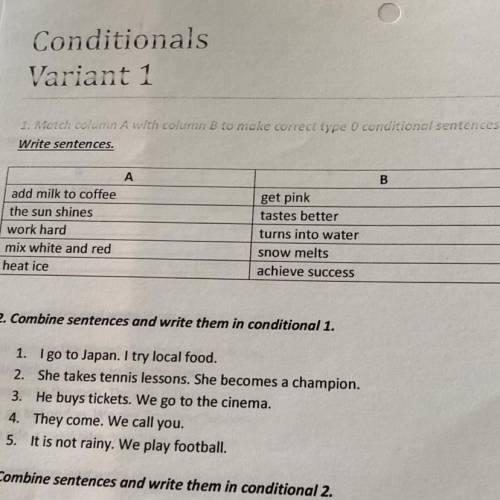4. .
1
Conditionals
Variant 1
a
T
1. Match column A with column B to make correct type o conditional sentences.
Write sentences.
A
B
add milk to coffee
the sun shines
work hard
mix white and red
heat ice
get pink
tastes better
turns into water
snow melts
achieve success

Другие вопросы по теме Английский язык
Популярные вопросы
- 1) 2х квадрат -8х-24=0 2)(15-х)(х-2)=(х-6)(х+5) 3) х квадрат -8х+12=0 на...
2 - Решить . №1 средняя скороть автомобиля на трассе -u км/ч, а на проселочной...
2 - Вбассейне ведется наблюдение за температурой воды. результатом одного измерения...
2 - Пальто стоит на 150 рублей дороже чем куртка.на пальто скинули 10%,на куртку...
3 - Xквадрат- 6x+11 найти наименьшее значение...
1 - Вмагазин яблоки и бананы. когда продали половину всех яблок и 2/з бананов,...
2 - Наташа отправила к новому году 14 открыток а к 8 марта 9 открыток.сама она...
2 - Как изменится сумма,если от первого слагаемого отнять 110,а ко второму прибавить...
3 - Длина часовой стрелки кремлёвских курантов 3,0 метров ,а длина минутной стрелки...
3 - Вырази числа: 9000 10000 50000 700000 а) в десятках б) в сотнях в) в тысячах...
3
B: tastes better
Sentence: If you add milk to coffee, it tastes better.
Explanation: In this conditional sentence, we have a cause and effect relationship. The cause is adding milk to coffee, and the effect is that it tastes better. The "if" clause introduces the condition, and the "result" clause shows the consequence of that condition.
A: the sun shines
B: turns into water
Sentence: If the sun shines, snow melts and turns into water.
Explanation: This conditional sentence suggests that when the sun shines, it has a direct effect on the snow. The result is that the snow melts and turns into water. The "if" clause introduces the condition, and the "result" clause shows the consequence of that condition.
A: work hard
B: achieve success
Sentence: If you work hard, you can achieve success.
Explanation: This conditional sentence implies that hard work leads to success. The "if" clause states the condition of working hard, and the "result" clause shows the potential consequence of that condition, which is achieving success.
A: mix white and red
B: get pink
Sentence: If you mix white and red, you get pink.
Explanation: This conditional sentence states the result of mixing white and red colors. When you mix these colors, the outcome is that you get the color pink. The "if" clause introduces the condition, and the "result" clause shows the consequence of that condition.
A: heat ice
B: turns into water
Sentence: If you heat ice, it turns into water.
Explanation: This conditional sentence explains the result of heating ice. When ice is subjected to heat, it melts and transforms into water. The "if" clause introduces the condition, and the "result" clause shows the consequence of that condition.
A: snow melts
B: the sun shines
Sentence: If snow melts, it means the sun shines.
Explanation: This conditional sentence suggests the relationship between snow melting and the presence of sunshine. When snow melts, it indicates that the sun is shining. The "if" clause introduces the condition, and the "result" clause shows the consequence of that condition.
In conclusion, conditional sentences help us express cause and effect relationships and show how one event or action can influence another.